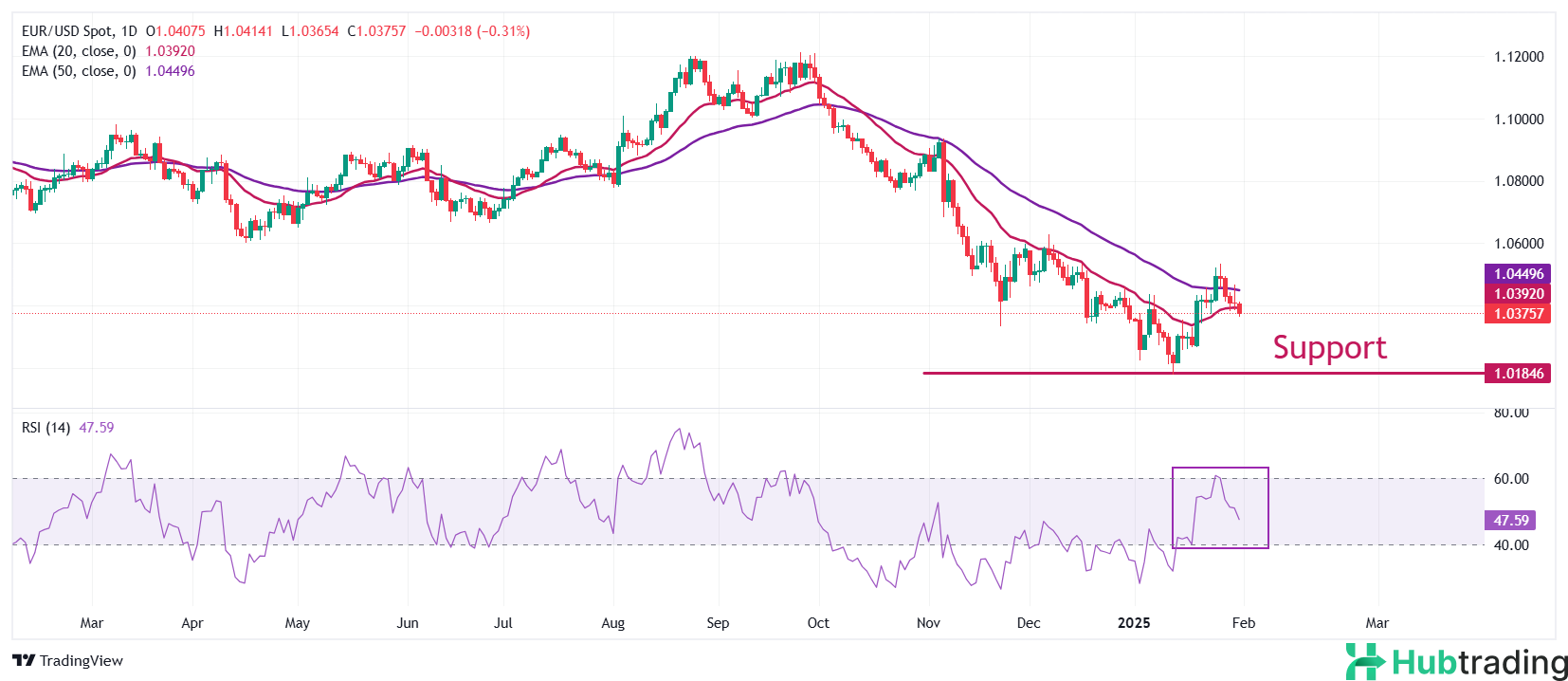- EUR/USD drops to around 1.0370 as inflation slows in six German states in January.
- Donald Trump warns of 100% tariffs on BRICS nations and 25% on Mexico and Canada.
- The Federal Reserve maintained interest rates unchanged on Wednesday.
EUR/USD faces selling pressure, sliding toward 1.0370 during Friday's European session as the euro weakens broadly amid cooling inflation in six German states. Softer-than-expected January Consumer Price Index (CPI) data has reinforced confidence that Eurozone inflation is steadily approaching the European Central Bank's (ECB) 2% target, strengthening the case for monetary policy easing.
On Thursday, ECB President Christine Lagarde expressed optimism about achieving victory over inflation this year. Following the central bank's decision to cut the Deposit Facility Rate by 25 basis points (bps) to 2.75%, she emphasized a data-dependent approach to future rate adjustments, stating that policy remains restrictive and that it is too soon to determine when easing will stop. Meanwhile, ECB policymaker and Estonian Central Bank chief Madis Muller echoed this sentiment on Friday, suggesting that inflation could realistically reach 2% by mid-year.
Looking ahead, market participants will turn their attention to the flash Eurozone Harmonized Index of Consumer Prices (HICP) for January, set for release on Monday. Before that, Germany's preliminary HICP data for January, due at 13:00 GMT on Friday, could provide further insight, though its impact may be muted given earlier state-level inflation readings.
Daily Market Movers: EUR/USD Weakens as Trump's Tariff Threats Boost USD Appeal
- EUR/USD Under Pressure Amid Strong USD Outlook: EUR/USD remains under selling pressure as the US Dollar (USD) maintains its strength, with the US Dollar Index (DXY) hovering around 108.20. The Greenback's safe-haven demand has risen after former US President Donald Trump reaffirmed his intention to impose steep tariffs on North American trading partners and BRICS nations.
- Trump's Stance on BRICS and USD Dominance : In a statement on his TruthSocial platform, Trump insisted that BRICS nations must commit to neither creating a new currency nor backing any alternative to the USD. He warned that any country attempting such a move would face 100% tariffs and risk losing access to the US market.
- Potential Inflationary Impact of Tariffs: Market analysts suggest that Trump is leveraging tariffs to advance his economic agenda. If imposed, such tariffs could drive inflation higher in the US, reinforcing the Federal Reserve's (Fed) case for maintaining interest rates at 4.25%-4.50% for an extended period.
- Fed Maintains Wait-and-See Approach: On Wednesday, the Fed left interest rates unchanged and reiterated its cautious stance, emphasizing the need for clear progress on inflation or signs of labor market weakness before considering any rate adjustments.
- Key Focus: US PCE Inflation Data: The next major market driver for the USD will be the US Personal Consumption Expenditure (PCE) Price Index for December, set for release at 13:30 GMT. Economists anticipate core PCE inflation to rise 0.2% month-over-month, up from 0.1% in November, while the annual core PCE is expected to hold steady at 2.8%.
Technical Analysis: EUR/USD Drops Below 20-Day EMA

EUR/USD declines toward 1.0370 during Friday's European session, slipping below the 20-day Exponential Moving Average (EMA) at 1.0390. The pair continues its downward correction after failing to hold above the 50-day EMA, which currently stands at 1.0449.
The 14-day Relative Strength Index (RSI) faces resistance near 60.00, signaling that the recent recovery was short-lived.
On the downside, key support levels are at 1.0266 (January 20 low) and 1.0177 (January 13 low). On the upside, the December 6 high of 1.0630 remains a critical resistance level for Euro bulls.





